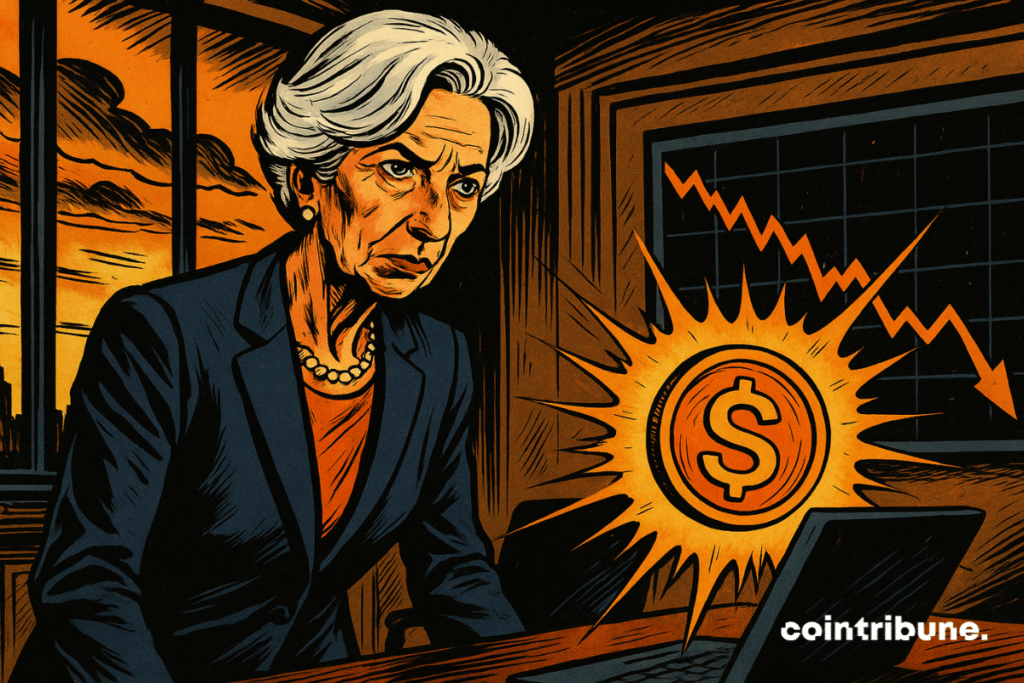Christine Lagarde Doubles Down: ’Stablecoins Pose Systemic Risks’—Crypto Braces for Impact
ECB chief fires warning shot across crypto's bow as stablecoin adoption surges.
The Eurozone's top banker isn't mincing words
Lagarde's latest salvo frames stablecoins as financial stability threats—just as Tether's market cap flirts with $100B. Timing's curious, given traditional banks' own liquidity crunches last quarter.
Regulators vs. innovation: Groundhog Day
Same playbook as 2018's crypto winter: warnings first, crackdowns next. But this time, the targets are dollar-pegged tokens propping up DeFi's $80B ecosystem.
The irony isn't lost
Sovereign currencies wobble while algo-stables hold their peg—wonder who's really got a stability problem here?

In Brief
- Stablecoins are accused by Lagarde of weakening monetary policies and state sovereignty.
- The ECB considers that public money is at risk against private cryptos like USDT or USDC.
- The US GENIUS Act already regulates stablecoins, while Europe hesitates on the digital euro.
- Stablecoins blur the line between currency, payment, and technology according to Lagarde and other central bankers.
Public Money, Private Interests: The Dilemma That Shakes Lagarde
After the alert issued by the BIS and the Bank of France on stablecoins, Christine Lagarde doesn’t mince her words. From a panel in Portugal, she stated:
I consider money as a public good, and we as public servants charged with protecting it.
Stablecoins, these cryptocurrencies backed by fiat currencies, arelike Tether or Circle. In 2024, USDT exceeded. For the ECB, thisdeprives central banks of a key tool: monetary policy.
Lagarde fears a: money, means of payment, and infrastructure. For her, stablecoins feed this ambiguity. They are neither an official currency nor a simple payment app, but an uncontrolled in-between.
On the other side, Andrew Bailey, governor of the Bank of England, shares the analysis:
They claim to fulfill the function of money’s medium of exchange, and therefore must meet the criterion of money… which essentially means guaranteeing the preservation of their nominal value.
The fear? Losing control over the interest rate lever, inflation, and ultimately… sovereignty.
Crypto, Euros, and Confusion: What the Public Often Ignores
Crypto moves fast, and institutions struggle to keep up. But why this sudden pressure to?
Lagarde sees an urgency here:
My concern is that this confusion leads to the privatization of money.
A nightmarish scenario for bank governors. When, the ECB’s power melts away. In June, Lagarde pushed the European Parliament to speed up the launch of the digital euro. The goal: counter this crypto invasion.
But while Europe hesitates, others are moving. In the United States, thesets a. In South Korea, capital flight toward these assets pushes Seoul to relax forex regulations.
The president of the Bank of Korea, Rhee Chang-yong, sums it up: “Without regulation, stablecoins could sabotage our capital flows.”
Meanwhile, the average user often confuses crypto, stablecoin, and digital euro. The real issue lies there: the semantic battle before the economic battle.
Stablecoins: The Quantified Anchor of a Paradigm Shift
To measure the influence of stablecoins, nothing beats the numbers. Their growth is no longer hypothetical but concrete, anchored in usage.
Behind Christine Lagarde’s alert hides a skyrocketing growth:
- 160 billion dollars: total value of stablecoins in circulation worldwide in 2024;
- USDT (Tether) represents over 65% of the global market;
- More than 80 central banks worldwide are exploring or developing their own digital currencies;
- In Europe, the digital euro is technically ready but still awaiting political approval;
- Dollar-backed stablecoins are attracting a growing share of financial flows, to the detriment of local currencies.
At the Sintra conference, Jerome Powell decided:
If we are going to have stablecoins — and apparently we will — there needs to be a regulatory framework.
The message is clear: they’re already here. The numbers don’t lie. They show that the future of money may well be rewritten outside the walls of central banks.
What banks fear may already be underway: the internet belongs to stablecoins. The network increasingly relies on these stable cryptos for exchange, commerce, and payment. The real question is not “should they be regulated?”, but rather: who owns the new infrastructure of the digital world?
Maximize your Cointribune experience with our "Read to Earn" program! For every article you read, earn points and access exclusive rewards. Sign up now and start earning benefits.

